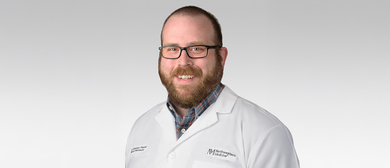Czas czytania: 5 min
14 listopada 2025
ZDROWIE SPOŁECZNOŚCI I ZDROWIE GLOBALNE
Artykuł
Advancing Antimicrobial Stewardship in Small and Rural Hospitals
An Interview with Kyle Johnicker, PharmD

Kyle Johnicker, PharmD.
Since earning his PharmD from Butler University in 2006, Dr. Kyle Johnicker has led antimicrobial-stewardship programs at three community hospitals. He pairs hands-on pharmacy practice with system-level policy work. We wanted his first-hand view of why closures of small hospitals imperil antibiotic effectiveness, how limited diagnostics and staffing fuel broad-spectrum overuse, and what concrete steps—even baby steps—can reverse that trend. The conversation that follows traces the challenges, the wins, and the policy levers he believes could keep rural hospitals open while protecting patients from rising resistance.
Small and rural hospitals are closing at a pace that alarms clinicians who serve those communities. “The thing we’re facing right now is even just keeping small rural hospitals open,” said pharmacist Kyle Johnicker, PharmD, Pharmacy Clinical Coordinator at Northwestern Medicine Kishwaukee Hospital in DeKalb, Illinois, noting the steady rise in closures over the last decade. A 2025 analysis by health information nonprofit KFF found hospital closures outpaced openings in rural areas from 2017 to 2024, and many rural hospitals have dropped specific service lines over time.1
When a hospital disappears, patients drive farther for care, larger facilities feel the bed crunch, and—critically—local efforts to contain antibiotic resistance lose their first line of defense.2.3 “If small and rural hospitals are not doing the same level of stewardship care, local communities will see increased resistance, which decreases opportunities for future treatment. And that snowball happens,” he added.
Hurdles to Overcome: Diagnostics and Lack of Specialization
When asked to detail the challenges he sees for antimicrobial stewardship at hospitals like his, Johnicker began with diagnostics: new in-house equipment is expensive, yet relying on reference labs stretches the timeline at every step—collection, courier pickup, transit, testing, and, finally, the $10 000 interface many hospitals must build to exchange results between the reference lab and the electronic health-record system if they don’t want to wait around for faxes. Until those results return, clinicians often stay “broader than is necessary for a lot longer,” he said, describing a culture of defensive prescribing, or a “shoot broad” mentality.
He also noted that few rural facilities can field an infectious disease consult team every day4; stewardship falls to family physicians, hospitalists, and pharmacists who juggle many roles. Treatment guidelines move quickly—for example, pneumonia courses that once ran ten days now finish safely in three to five for the right patients—and keeping pace can feel daunting.
System Support and an Open-Access Playbook
Because his hospital belongs to the larger Northwestern Medicine system, Johnicker has access to academic-center protocols he can adapt to his smaller site. But for others, he pointed readers to the publicly available Antimicrobial Diagnostic Stewardship Program website, where Northwestern posts guidelines and patient-education tools for anyone to use.
"We want everybody to have access to the best stewardship practices that exist," he said.
Emphasizing the critical role pharmacists play, Johnicker noted that translating protocols like those shared by Northwestern sometimes means pharmacists must “step up and fill the gap” by double-checking orders or coaching prescribers in real time.
A Case Study in Urinary Tract Infection Therapy
An example of the hands-on impact pharmacists can have in a small rural hospital comes from a dramatic turnaround in empiric UTI treatment at Johnicker’s site.
In early 2022 nearly 80 percent of uncomplicated cystitis cases began with broad-spectrum third-generation cephalosporins. After reviewing local antibiogram data, Johnicker’s team showed prescribers that first-generation agents offered the same bacterial coverage with less collateral damage.
Pharmacists began reviewing orders in real time, confirming cultures, and recommending the narrower option. Within a few months first-generation cephalosporins accounted for roughly three-quarters of initial therapy—a shift the team has sustained for more than two years.
The benefits were widespread. Clinicians appreciated the evidence-based approach; patients benefited from fewer broad-spectrum exposures; and hospital leaders saw improvement in a nationally reported quality metric—hospital-onset Clostridioides difficile infections—that also carries reimbursement implications. By aligning patient safety, regulatory performance, and prudent use of resources, the project demonstrated how even a small protocol change can deliver lasting benefits for rural hospitals and the communities they serve.
Stewardship Beyond the Hospital
Rural health systems often run outpatient clinics and urgent-care sites, where unnecessary antibiotics for viral respiratory illness remain common.5
“Sixty percent of all antibiotics are unnecessary because we’re treating viral respiratory infections,” Johnicker said, noting that even though they are often overstretched, retail pharmacists often make an impact by intervening before a prescription reaches the patient.
The Policy Lever: Recognizing Pharmacists as Providers
Johnicker believes that national provider status for pharmacists could accelerate stewardship progress. Most stewardship work—dosing consults, culture reviews, follow-ups—is not billable today. If pharmacists could bill like other consultants, rural hospitals would gain a new revenue stream that might literally keep doors open, Johnicker argued.
The Strength of Community
System resources help, but peer networks matter just as much. Small hospitals, Johnicker said, “are all in a very similar boat,” and pharmacists freely share protocols and hard-won lessons without expecting anything in return.
”I think the answer is community–reach out, network, and have those conversations,” he encouraged.
“It’s Never Too Late to Start”
For leaders overwhelmed by broad empiric regimens and limited staff, Johnicker offers reassurance: begin anywhere.
Whether that first step is tightening a single surgical-prophylaxis order set or phoning a colleague at the next critical-access hospital, each improvement slows the resistance snowball and, ultimately, keeps rural healthcare viable.
"It’s never too late to start and every baby step you make is a step in the right direction,” he said.
Piśmiennictwo:
1. Hulver, S., Levinson, Z., Godwin, J., & Neuman, T. (2025, April 16). 10 Things to Know About Rural Hospitals. KFF. https://www.kff.org/health-costs/10-things-to-know-about-rural-hospitals/
2. U.S. Government Accountability Office. (2023, May 16). Why health care is harder to access in rural America. https://www.gao.gov/blog/why-health-care-harder-access-rural-america[1](https://www.gao.gov/blog/why-health-care-harder-access-rural-america)
3. Centers for Disease Control and Prevention. (2025, February 4). Antimicrobial resistance facts and stats. https://www.cdc.gov/antimicrobial-resistance/data-research/facts-stats/index.html[2](https://www.cdc.gov/antimicrobial-resistance/data-research/facts-stats/index.html)
4. U.S. Government Accountability Office. (2024, May 2). Public-health workforce shortage undermines ability to respond to outbreaks and other emergencies. Center for Infectious Disease Research and Policy (CIDRAP). https://www.cidrap.umn.edu/public-health/gao-public-health-workforce-shortage-undermines-ability-respond-outbreaks-other[1](https://www.cidrap.umn.edu/public-health/gao-public-health-workforce-shortage-undermines-ability-respond-outbreaks-other)
5. Centers for Disease Control and Prevention. (2024, April 12). Core elements of antibiotic stewardship. U.S. Department of Health & Human Services. https://www.cdc.gov/antibiotic-use/hcp/core-elements/index.html[1](https://www.cdc.gov/antibiotic-use/hcp/core-elements/index.html)
The views, opinions, and or data expressed in this content reflect the experience of the interviewee and do not necessarily reflect the position of Cepheid.
Czytaj dalej
WIĘCEJ







